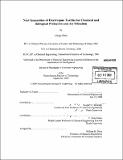Next generation of electrospun textiles for chemical and biological protection and air filtration
Author(s)
Chen, Liang, Ph. D. Massachusetts Institute of Technology
DownloadFull printable version (16.61Mb)
Other Contributors
Massachusetts Institute of Technology. Dept. of Chemical Engineering.
Advisor
Gregory C. Rutledge and T. Alan Hatton.
Terms of use
Metadata
Show full item recordAbstract
(cont.) only in the presence of water, which serves as a medium promoting the nucleophilic action of the amidoximes in the fibers. Bactericidal fiber mats were produced from electrospinning of blends containing a biocide chlorhexidine (CHX). A small amount of high molecular weight poly(ethylene oxide) was incorporated into the blends to facilitate the electrospinning and a dimensionless Deborah number (De) was introduced to determine the spinnability of the blends. The resultant fiber mats demonstrated bactericidal properties, killed representative bacteria of E. coli and S. epidermidis not only through a gradual release of unbound CHX from the fibers but also via contact with CHX bound to the fibers. In addition, antibacterial fiber mats were obtained by a post-spin treatment of cellulose acetate fibers. The latter material allowed for the covalent CHX immobilization on the fibers via titanate linkers. The layer-by-layer (LbL) electrostatic assembly technique was applied in combination with electrospinning technique to fabricate novel, breathable electrospun fiber-based protective fabrics and filters for both chemical and biological protection. Reactive polyanion, polyhydroxamic acid, which can decompose OP nerve agents, and antimicrobial polycation, poly (N-vinylguanidine), were synthesized and LbL-assembled onto electrospun fibers to achieve multifunctional coatings. The capability of these functionalized fabrics to detoxify representative chemical and biological toxic agents and their mimics was demonstrated. The breathability of the functionalized electrospun fiberbased systems was addressed.
Description
Thesis (Ph. D.)--Massachusetts Institute of Technology, Dept. of Chemical Engineering, 2009. Cataloged from PDF version of thesis. Includes bibliographical references.
Date issued
2009Department
Massachusetts Institute of Technology. Department of Chemical EngineeringPublisher
Massachusetts Institute of Technology
Keywords
Chemical Engineering.